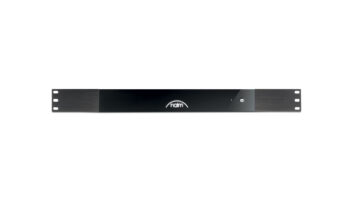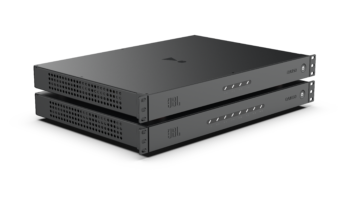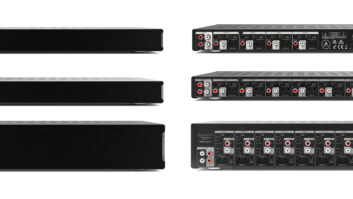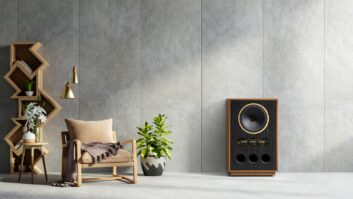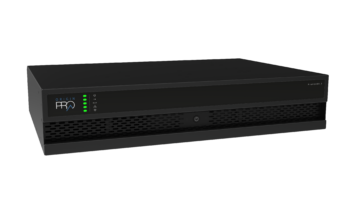Professional-quality audio, one of the staples of custom integration, has been among the most disrupted spheres of the industry in recent years as wireless speakers and streaming technologies continue to grow in popularity. But, there’s good news for great sound: amplifier manufacturers have been working hard to remain on the cutting edge–packing a plethora of network-friendly capabilities into units that combine the high-quality experience that integrators strive to deliver with the flexibility that consumers crave.
The main requirement of modern amplifiers is network connectivity, something SnapAV’s Autonomic has focused on for some time. “Whole-house entertainment amplifiers must be decentralized networked devices offering maximum flexibility for integrators,” said Michael de Nigris, vice president, audio products at SnapAV. “Many homes have been wired for extensive network coverage, and integrators can offer superior performance and value utilizing network-connected amplifiers that provide tremendous placement flexibility, without the need for homerun wiring from each zone to a centralized equipment rack.”

Autonomic’s Mirage M-801e features eAudioCast for high-quality network transport of audio, and is expandable up to 96 rooms.

AudioControl’s amplifiers, like the M4800, feature onboard DSP and custom profiles tailored for specific models of architectural speakers.
According to de Nigris, Autonomic’s eSeries amplifiers utilize eAudioCast, a sophisticated transmission algorithm that prevents degradation of sound quality in transit to any zone within a home–no matter how large. The Mirage M-801e is an eight-zone, IP controllable amplifier, expandable to 96 rooms, with extensive zone linking capabilities. It can be used as a standalone distribution amplifier, or paired with a Mirage Media Server to complete a fully integrated audio solution.
NAD Electronics also offers an expandable approach to networked amplifiers, with a twist. The NAD CI 720 Network Stereo Zone Amplifier comes in a unique “blade” form factor, enabling expansion to cover six zones in 3RU of space. “NAD believes that there’s been a big gap in the available network streaming options for distributed multiroom audio, a core element in every custom integration project,” said Greg Stidsen, director of technology and product planning for NAD Electronics. “Our pioneering work in the area of digital technology has resulted in the new Hybrid Digital amplifier platform that is astounding audiophiles the world over, achieving levels of detail, transparency, and power never achieved at these price points before.”
The CI 720, which provides 60W continuous power with an available dynamic capacity of 165W, features BluOS, the high-resolution multiroom wireless audio solution developed by NAD’s sister brand Bluesound. BluOS offers the ability to stream audio from local collections or popular cloud services like Tidal, Spotify, Qobuz, and others. It also enables deep integration with several of the top control systems, including Control4, Crestron, and RTI, and has a published API that allows a more complete and sustainable integration.

The NAD CI 720 features BluOS, the highresolution multiroom wireless audio solution developed by sister brand Bluesound.
Of course, the chief benefit of a traditional amplifier-based home audio solution is the much higher quality sound it can provide; however, it can be difficult to demonstrate this advantage without good media content. That’s why companies like Meridian have put a strong emphasis on Hi-Res audio formats, as a means of highlighting the superiority of their hardware, such as the Meridian 258 eight-channel amplifier.
“As a brand that is committed to Hi-Res audio and delivering the best possible experience for any application, we understand the importance of seamless integration,” said Ryan Donaher, Meridian America VP of sales and marketing. “That’s why our design and engineering team is bringing products like the Meridian 258 amplifier to market, and what gives the custom installation community a real opportunity to offer something tangibly better. Moreover, the Meridian 258 offers a fantastically powerful and efficient way to drive passive loudspeakers, at a price point that is profitable for the dealer and palatable by their customers.”
According to Donaher, the Meridian 258 is also designed to be more cost effective for integrators to specify. Housed in a 1RU chassis, its Class D power provides 100W per channel at 4 ohms (or 70W into 8 ohms) efficiently and at a low operating temperature, such that no internal fan or external cooling is required.

The Meridian 258 amp fits common requirements of integrators, namely high power output and network capability in a compact, 1RU chassis.
Simplifying (and optimizing) setup is a hallmark of AudioControl, which is celebrating its 40th year in business in 2017. AudioControl multizone amplifiers, like the Director M4800, include onboard DSP and custom profiles tailored for specific models of architectural speakers, so that audio systems sound great with minimal adjustment required. “Integrators today require more features, higher power output, and reliability from amplifiers that use minimal rack space,” said Alex Camara, CEO of AudioControl. “Network ports are helpful for control and monitoring, and advanced DSP functionality with EQ enables integrators to deliver better sound tailored for each unique environment. Onboard loudspeaker profiles from a growing list of partner companies save time and add value for integrators.” The M4800 fits the bill for Camara’s list of requirements, with 100W per channel at 8 ohms (200W at 4 ohms) in a 1RU-high unit.
Anthem also strives to make its offerings as integrator friendly as possible, and its STR Integrated Amplifier line is no exception. An audiophile-grade, two-channel amp, the STR features inputs for moving-magnet and moving-coil phono cartridges, and a high-resolution preamplifier section and high-current, high-output amplifier section, providing 600 watts of continuous power at 2 ohms. Add to these capabilities the company’s proprietary room correction technology, and the STR offers a solid audio proposition.

The two-channel STR Integrated Amplifier from Anthem features Anthem Room Correction, allowing integrators to optimize acoustic performance on a room-byroom basis.
“The integration of ARC (Anthem Room Correction) allows integrators to optimize acoustic performance on a room-by-room basis and can even be used to account for varying acoustic conditions within a single room, for example, screen-up versus screen-down,” said Nick Platsis, product manager at Anthem. “Additionally, ARC communicates through IP so a computer attached to the same network can easily take room measurements when equipment is in a different location.”
One location in the home that will always need a solid, traditional amplifier is the theater, and the popularity of immersive audio formats has been a major driver in this space. StormAudio, the audio hardware brand of Auro Technologies, has been breaking new ground in this category, with preamp/processors that can drive up to 32 channels and handle all three 3D audio formats. The company’s flagship ISP 3D.32 ELITE | Reference Edition preamp/processor also incorporates Dirac Live room correction technology, as well as Audio Video Bridging (AVB) to streamline setup and configuration.

StormAudio’s flagship ISP 3D.32 ELITE | Reference Edition preamp/processor incorporates Dirac Live room correction technology and Audio Video Bridging (AVB).
“Essentially, the processor and each speaker are connected via standard RJ45 cables to an AV-enabled network router that manages the audio routing, delivering real-time audio-video streams to the speakers over the Ethernet-based network,” said StormAudio product manager Sébastien Gailleton. “This eliminates the signal degradation inherent to digital-to-analog and analog-to-digital domain conversion of the traditional processor/amp chain.”
A mainstay in the home theater category, JBL has upgraded its Synthesis line of amplifiers with enhancements like Ethernet networking connectivity. The eight-channel SDA-8300 delivers 300 watts into 8 ohms, and the four-channel SDA-4600 provides 600 watts into 8 ohms, and both are designed to work hand in hand with other JBL Synthesis electronics via networking ports.
“Our new SDA-8300 and SDA-4600 represent the next-generation of JBL Synthesis power amplifiers and offer significantly improved performance along with flexible networking capabilities in a JBL Synthesis custom-installation home theater system,” said Jim Garrett, director of marketing and product management, Harman Luxury Audio. “Adding to their appeal, the new amplifiers sound better, offer exceptional energy efficiency, and have space-saving form factors that allow greater placement and installation flexibility.”
So, like any aspect of the industry that’s been shaken up by shifting demands, amplifier manufacturers have been rising to the occasion and producing new products that accommodate popular new technologies within the framework of a professional-quality system that audiophiles have come to expect. By combining consumer-friendly features that extend the category’s versatility with integrator-focused abilities that simplify and enhance system setup, everybody wins.
Matt Pruznick is senior editor for Residential Systems and Systems Contractor News. Follow him on Twitter @Pruznick.
